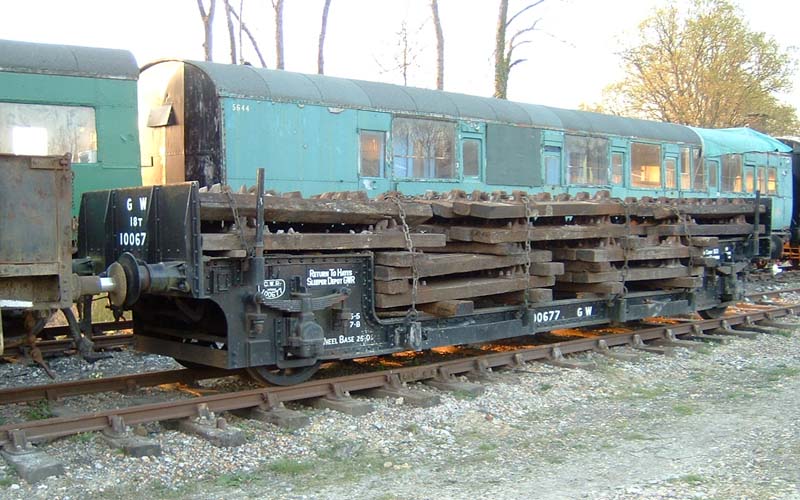100677 is a Diagram T12 wagon designed by the Great Western Railway to carry wooden sleepers from
their creosoting plant at Hayes, Middlesex to a work site. Built in 1938 at the GWR Swindon Works as
part of a lot (No.1313) of eighteen vehicles, it has a carrying capacity of 18 Tons, is fitted with
vacuum brakes and has a design tare weight of 11 Tons 16 cwt. It is fitted with a Dean/Churchward
ratchet handbrake.
To assist in loading, the side stanchions are in two halves, designed to slot together. There are
pockets for holding-down chains on each side of the wagon. In theory, 100677 is able to carry 160
sleepers fitted with chairs. Unlike most GWR wagons, this one has no code name.
These wagons joined an existing fleet of 101 similar, but slightly smaller wagons built to Diagram T1.
The last diagram T1 wagon was completed in 1900 and the design was fitted with a handbrake only. A
further six vacuum-braked wagons were built in 1942/3; these being similar to the diagram T12
vehicles, but fitted with a lever handbrake.
Most of the sleepers used prior to Nationalisation were cut from softwood. These had to be
pressure-treated with creosote to prevent rot. The "timbers" used under pointwork were normally
hardwood, which did not need to be pressure-treated.
The cast-iron chairs which were fitted to the sleepers were designed to fit the weight and profile of
the rail used. For example, the LB&SCR used a 96 lb./yard rail while standard bullhead rail weighs
95 lb./yard. The GWR widely used a 97.5 lb./yard rail coded "00" and all fittings were thus marked.
The wagon was purchased to assist with permanent way work on the Bluebell Railway and arrived on 8 September 1981. In recent years the wagon has no longer been required for engineering work, and a review conducted by the Bluebell's Rolling Stock sub-committee in 2021/2 concluded that this wagon, which would only ever have worked internally on the GWR system, was surplus to our collection, and it left on 25 May 2022 for a new home in GWR territory.
Current status: see Railway Heritage Register
Recommended reading:
GWR Goods Wagons by A.G. Atkins, W. Beard & R. Tourret (Oxford Publishing Co. 2013)
ISBN-10: 0860936570. ISBN-13: 978-0860936572.
This may be available from the Bluebell Shop at Sheffield
Park.
Used, older editions of this book may be available in the Carriage Shop at Horsted Keynes.









